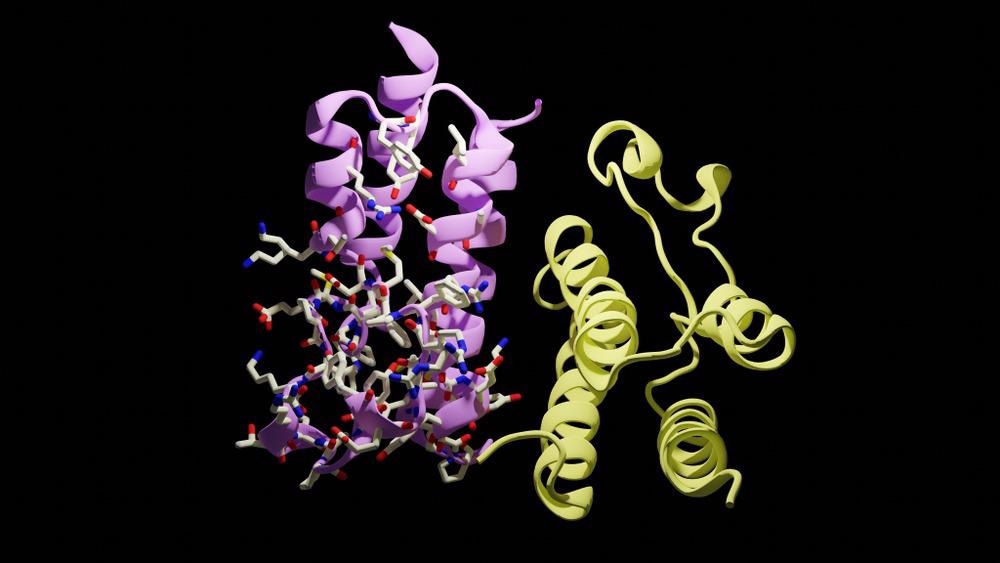Without changing the genetic code, chemical modifications to DNA and histone proteins can modulate the differential expression of genes. This network of chemical tags is termed the epigenome.

Image Credit: majcot/Shutterstock.com
Epigenetic tags can recruit “reader” proteins with various functions to local genes. These accessory proteins bind to histone modifications and influence the local chromatin structure, as well as the transcriptional status of genes within this region. Differences in these modifications can change gene expression and are often associated with disease.
Modifications affecting DNA indirectly
The density of chromatin structure is largely defined by nucleosomes. Made up of histone proteins and DNA, nucleosomes pack into either heterochromatin (dense) or euchromatin (loose) states, depending on the affinity of these molecules for one another.
Histone octamer cores, form from two H2A-H2B dimers and one (H3)2-(H4)2 tetramer. With roughly a quarter of the amino acid content in histones represented by arginine or lysine, these proteins carry a net positive charge. Wrapping around the outside of this core, ~145–147bp of negatively charged DNA forms a left-handed superhelix.
Extending from the nucleosome, histone amino-terminal tails can undergo chemical modification. Acetylation and methylation are among the most studied epigenetic markers. By altering or interfering with the DNA-histone interactions, the addition of acetyl and methyl groups can induce changes to the structure of chromatin. This in turn exerts regulatory influences over gene expression.
Acetylation and deacetylation of histone proteins
The ability of accessory proteins to bind DNA is influenced by the density of chromatin. Post-translational modification of histone proteins can decrease their positive charge and cause looser chromatin packing. DNA with looser connections to histone complexes exposes additional regions of DNA for transcriptional machinery to access.
Through covalent modification of histone proteins, the epigenome is able to alter the affinity of proteins for DNA. Histone acetyltransferase catalyzes the addition of acetyl groups to lysine residues of H3 and H4 histone subunits. This adds a negative charge to the N-terminus of histone proteins, reducing their affinity for negatively charged DNA. The resulting relaxed chromatin conformation, or euchromatic state, allows transcription factors to bind and significantly increases the expression of genes within the region.
Deacetylation, on the other hand, contributes to gene repression. Removal of acetyl groups from histone tails favors a heterochromatic state and prevents the recruitment of bromodomain-containing DNA binding proteins. The combination of these mechanisms allows the epigenome to regulate the binding of the transcriptional machinery and repress the expression of local genes.
In addition to acetyl groups, histones proteins can be marked with methyl groups, ubiquitin, phosphate, carbohydrate, small ubiquitin-like modifier (SUMO), and various other chemical tags. These modifications can occur on lysine and arginine residues, as well as serine and threonine residues. Though less studied than their acetyl counterparts, the degree and position of these modifications are known to influence processes of gene regulation and DNA repair.
Histone ubiquitination and phosphorylation
While all histone core proteins can undergo ubiquitination, the H2A and H2B subunits are the most commonly tagged. Interestingly, these subunits are also among the most highly ubiquitylated proteins in the nucleus. While the influence of ubiquitin tagging on histones can vary, deubiquitination seems to play an equally important role in regulating chromatin structure.
Acting as binding sites for various factors, ubiquitylated histones recruit accessory functions with implications in transcription, DNA replication, and repair. This includes the recruitment and stimulation of histone-modifying enzymes. One of the most well-studied examples of this is the recruitment and activation of histone methyltransferases, DOT1L and SET1, at ubiquitinated H2B. The levels of histone ubiquitination have been closely linked to the presence of other post-translational modifications and histone-modifying enzymes.
Ubiquitin-tagged histones communicate with other post-translational modifications to instruct complex functions. Phosphorylation of histone proteins, as well as ubiquitylated histones, can alter chromatin structure during cell division, transcriptional regulation, and DNA damage repair. Phosphorylated serine and threonine residues alter the electrostatic and topographic properties of histones, such that nucleosomes are less densely packed. Modification of ubiquitin by phosphorylation is a relatively unexplored concept but is known to regulate the DNA damage repair signaling cascade at sites of damage-induced ubiquitination.

Image Credit: sanjaya viraj bandara/Shutterstock.com
Post-translational histone methylation
Unlike with other epigenetic marks, methylation of histones does not alter the charge of proteins. Instead, adding methyl groups modulates the transcriptional status of local genes by recruiting accessory proteins. Histone methylation has also been implicated in a number of biological processes, including DNA repair. Dynamic regulation of methylation patterns on histones can impart complex information.
Depending on the degree of methylation, as well as the lysine and arginine residues methylated, the epigenome can either repress or promote expression. Methylation of lysine and arginine residues in histones can recruit proteins with methylation reader domains, such as PWWP, chromodomain, PHD, Tudor, and WD40. Monomethylation of lysine residues on H3 and H2 proteins has been associated with gene activation; while trimethylations of lysine residues in H3 have been linked to repression.
Silencing by methylation of DNA bases
Regions of DNA rich in cytosine and guanine, termed CpG islands, are found upstream of some 40-50% of human genes. What’s more, in the mammalian genome, ~70% of the 5’-CpG-3’ sequences are seen to contain methylated cytosine.
Methylation is the only modification known to occur on all components of the central dogma. The carbon 5 position on cytosine bases can undergo methylation. By protruding into the major groove of DNA, 5-methylcytosine can interfere with the binding of proteins; or act to recruit proteins involved in gene repression.
The dynamic and interlinked nature of epigenetic modifications allows for complex patterns to be imparted on gene regulation. Whether by changes to the structure and electrostatic properties of chromatin or by altering DNA-protein interactions, the epigenome is able to control gene expression. Dictating cell specialization and function, altering these epigenetic markers is associated with various diseases and cancers.
Sources:
- Berg, J. M., et al. (2002). Biochemistry. New York: W.H. Freeman.
- Brown, T.A. (2017) Genomes 4. [Online] Yale J Biol Med. Available at: https://www.ncbi.nlm.nih.gov/pmc/articles/PMC5733849/. (Accessed on 1 November 2021).
- National Human Genome Research Institute. (2020) Epigenomics Fact Sheet. [Online] National Institute of Health. Available at: www.genome.gov/about-genomics/fact-sheets/Epigenomics-Fact-Sheet. (Accessed on 14 November 2021).
- Musselman CA, Lalonde ME, Côté J, Kutateladze TG. Perceiving the epigenetic landscape through histone readers. Nat Struct Mol Biol. 2012;19(12):1218-1227. doi:10.1038/nsmb.2436
- Gong F, Miller KM. Histone methylation and the DNA damage response. Mutat Res Rev Mutat Res. 2019;780:37-47. doi:10.1016/j.mrrev.2017.09.003
- Mattiroli, F., and Penego, L. (2021) Histone Ubiquitination: An Integrative Signaling Platform in Genome Stability. Trend in Genetics. doi.org/10.1016/j.tig.2020.12.005
- Weake, V.M., and Workman, J.L. (2008) Histone Ubiquitination: Triggering Gene Activity. Molecular Cell. doi.org/10.1016/j.molcel.2008.02.014
Further Reading